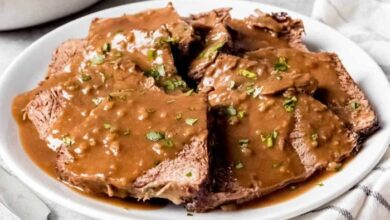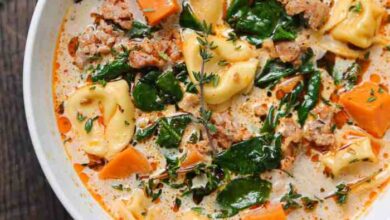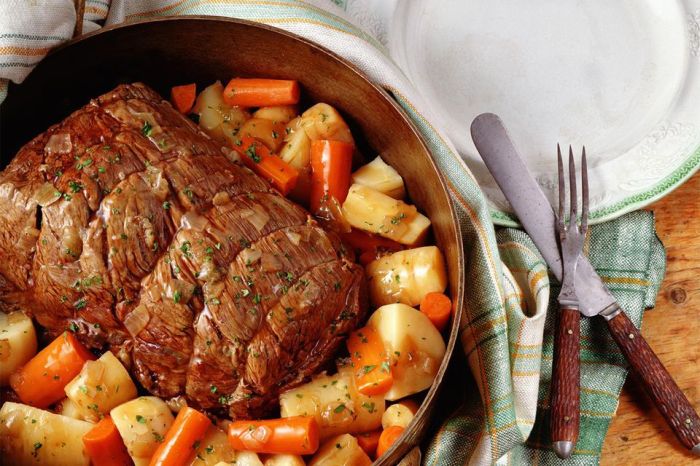
Pot Roast with Vegetables: A Comforting Classic
Pot roast with vegetables, a dish that evokes memories of cozy evenings and hearty meals, has been a staple in kitchens worldwide for centuries. This comforting classic transcends cultures, offering a symphony of flavors that tantalize the taste buds and warm the soul.
From its humble origins to its modern-day variations, pot roast with vegetables continues to be a beloved dish, captivating cooks and diners alike.
The beauty of pot roast with vegetables lies in its simplicity. A humble cut of beef, slow-cooked to tender perfection, is joined by a medley of fresh vegetables, creating a dish that is both nourishing and delicious. The slow cooking process allows the flavors to meld and deepen, resulting in a rich, savory broth that complements the tender meat and succulent vegetables.
Introduction to Pot Roast with Vegetables

Pot roast with vegetables is a comforting and flavorful dish that has been enjoyed for centuries. Its origins can be traced back to the ancient practice of slow-cooking meat over an open fire, a technique that was prevalent in many cultures around the world.
The simplicity and versatility of pot roast have made it a staple in various cuisines, adapting to local ingredients and cooking methods.
Types of Pot Roast Cuts, Pot roast with vegetables
The type of meat used for pot roast is a crucial factor in determining its flavor and texture.
- Chuck Roast:This cut is known for its marbling and rich flavor, making it ideal for pot roast.
- Brisket:A tough but flavorful cut, brisket requires long cooking times to become tender and juicy.
- Round Roast:A leaner cut, round roast can be used for pot roast, but it may require additional moisture to prevent it from drying out.
Vegetables Commonly Used
A variety of vegetables can be added to pot roast to enhance its flavor and nutritional value.
- Root Vegetables:Carrots, potatoes, and parsnips are popular additions to pot roast, adding sweetness and earthy flavors.
- Onions and Garlic:These aromatics provide depth of flavor and create a rich sauce.
- Other Vegetables:Depending on personal preference, other vegetables like celery, mushrooms, and green beans can be incorporated into the dish.
Ingredients and Preparation: Pot Roast With Vegetables
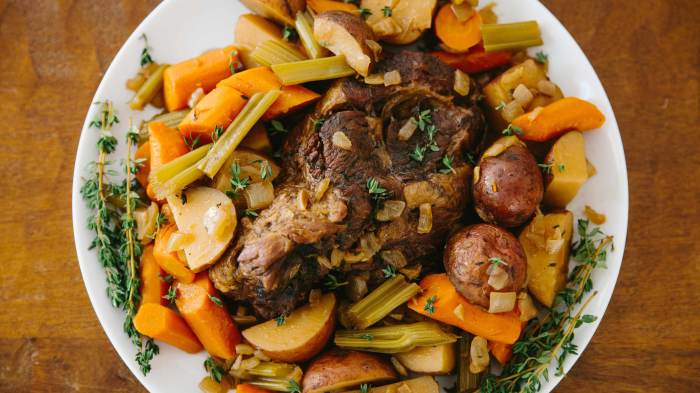
A pot roast with vegetables is a hearty and comforting dish that’s perfect for a cold winter night. The key to a successful pot roast is using high-quality ingredients and taking the time to properly prepare them. This ensures that the meat is tender and flavorful, and the vegetables are cooked to perfection.
Choosing and Preparing the Pot Roast
The first step in making a pot roast is selecting the right cut of meat. A good choice for pot roast is a chuck roast, which is a tougher cut of meat that benefits from slow cooking. Other good options include a rump roast or a bottom round roast.
- Trimming the Pot Roast:Before cooking, trim any excess fat from the pot roast. This will help to prevent the roast from being too greasy. You can also remove any tough membranes or silver skin from the roast.
- Seasoning the Pot Roast:Season the pot roast generously with salt, pepper, and any other herbs or spices you like. You can also use a commercial pot roast seasoning blend.
Selecting and Preparing the Vegetables
The vegetables you choose for your pot roast will depend on your personal preference. Some popular choices include carrots, potatoes, onions, celery, and garlic.
- Preparing the Vegetables:Wash and peel the vegetables. Chop the vegetables into bite-sized pieces. If you are using potatoes, you can cut them into large chunks or leave them whole.
- Roasting the Vegetables:You can roast the vegetables in the oven for 30 minutes before adding them to the pot roast. This will give them a nice caramelized flavor.
Cooking Methods and Techniques
There are several cooking methods that can be used to prepare pot roast with vegetables, each with its own advantages and disadvantages. The choice of cooking method will depend on factors such as the desired tenderness and flavor of the meat, the type of vegetables being used, and the available cooking time.
Slow Cooking
Slow cooking is a popular method for preparing pot roast, as it results in a tender and flavorful dish. The low and slow cooking process allows the meat to break down and become more tender, while the vegetables soften and develop rich flavors.
Advantages
- Tender and flavorful meat
- Simple and hands-off cooking method
- Suitable for tough cuts of meat
Disadvantages
- Long cooking time (typically 6-8 hours)
- May require additional liquid to prevent the meat from drying out
Tips and Techniques
- Use a slow cooker or Dutch oven with a tight-fitting lid to trap moisture and heat.
- Brown the meat before adding it to the slow cooker to enhance flavor.
- Add a small amount of liquid, such as broth or wine, to the slow cooker to prevent the meat from drying out.
- Cook the meat on low heat for a longer period of time, or on high heat for a shorter period of time.
- Add vegetables towards the end of the cooking time to prevent them from becoming mushy.
Braising
Braising is a technique that involves searing the meat in a pan, then simmering it in a small amount of liquid in a covered pot or Dutch oven. This method results in a tender and flavorful dish, similar to slow cooking, but with a shorter cooking time.
Advantages
- Tender and flavorful meat
- Shorter cooking time than slow cooking (typically 2-3 hours)
- Creates a rich and flavorful sauce
Disadvantages
- Requires more attention than slow cooking
- May require additional liquid to prevent the meat from drying out
Tips and Techniques
- Use a Dutch oven with a tight-fitting lid to trap moisture and heat.
- Sear the meat on all sides in a hot pan to develop a crust and enhance flavor.
- Add a small amount of liquid, such as broth, wine, or water, to the pot.
- Bring the liquid to a simmer and cook the meat until it is tender, typically 2-3 hours.
- Add vegetables towards the end of the cooking time to prevent them from becoming mushy.
Roasting
Roasting is a dry-heat cooking method that involves cooking the meat and vegetables in an oven. This method results in a crispy exterior and tender interior for the meat, and roasted vegetables with a caramelized flavor.
Advantages
- Crispy exterior and tender interior for the meat
- Caramelized vegetables with a rich flavor
- Simple and hands-off cooking method
Disadvantages
- May require more frequent basting to prevent the meat from drying out
- May not be suitable for tough cuts of meat
Tips and Techniques
- Preheat the oven to a high temperature (400-450°F) for the first 30 minutes to sear the meat and develop a crust.
- Reduce the oven temperature to 325°F and continue roasting until the meat is tender, typically 1-2 hours.
- Baste the meat with pan juices or broth every 30 minutes to prevent it from drying out.
- Add vegetables towards the end of the cooking time to prevent them from becoming mushy.
Flavor Variations and Enhancements
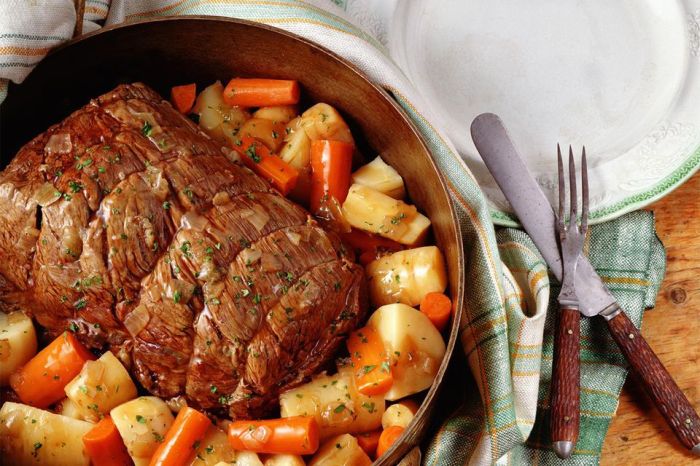
Pot roast with vegetables is a versatile dish that can be customized to your liking. With a few simple additions, you can elevate the flavor profile and create a truly unique culinary experience.
Herb and Spice Combinations
Herbs and spices play a crucial role in adding depth and complexity to the flavor of pot roast. Experimenting with different combinations can lead to surprising and delightful results.
- Classic Combination:Thyme, rosemary, and garlic are staples for a traditional pot roast flavor. These herbs provide a savory and earthy base, while garlic adds a pungent and aromatic note.
- Mediterranean Twist:Oregano, basil, and bay leaves lend a Mediterranean flair to the dish. These herbs offer a bright and herbaceous aroma, complementing the richness of the meat.
- Spicy Kick:For a touch of heat, consider adding chili powder, paprika, or cayenne pepper. These spices add a warm and spicy dimension to the roast, balancing the sweetness of the vegetables.
- Sweet and Savory:A combination of brown sugar, onion powder, and black pepper creates a sweet and savory profile that complements the richness of the pot roast.
Sauce and Gravy Variations
The sauce or gravy accompanying the pot roast is essential for enriching the flavors and creating a satisfyingly moist and flavorful dish. Here are some variations to consider:
- Traditional Brown Gravy:This classic gravy is made from the pan drippings, flour, and broth, resulting in a rich and savory sauce that complements the pot roast perfectly.
- Creamy Mushroom Gravy:For a decadent and flavorful sauce, try adding sliced mushrooms and cream to the traditional gravy recipe. The mushrooms add an earthy depth, while the cream creates a luxuriously smooth texture.
- Wine-Based Gravy:A splash of red wine adds a fruity and complex flavor to the gravy. Use a full-bodied red wine like Cabernet Sauvignon or Merlot for the best results.
Additional Flavor Enhancers
Incorporating additional ingredients can further enhance the flavor profile of pot roast with vegetables. Consider adding:
- Mushrooms:Sliced or whole mushrooms add an earthy and savory flavor to the dish. They can be added directly to the pot or sautéed separately and stirred in towards the end of cooking.
- Onions and Garlic:Sautéed onions and garlic add a sweet and pungent aroma that complements the meat and vegetables. Use a combination of yellow and red onions for a balanced flavor profile.
- Citrus Fruits:A squeeze of lemon or orange juice adds a bright and tangy note to the dish. Use citrus zest for an additional layer of flavor and aroma.


